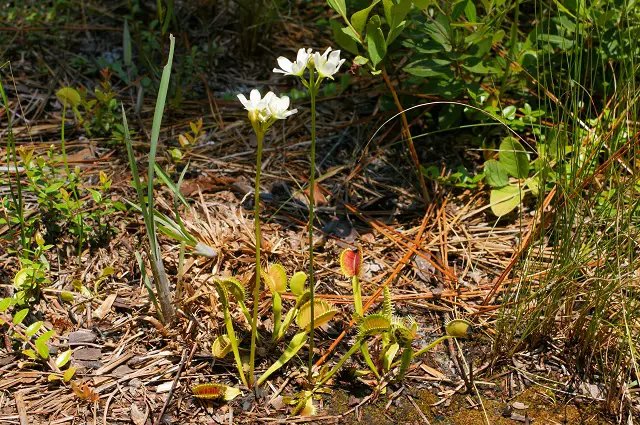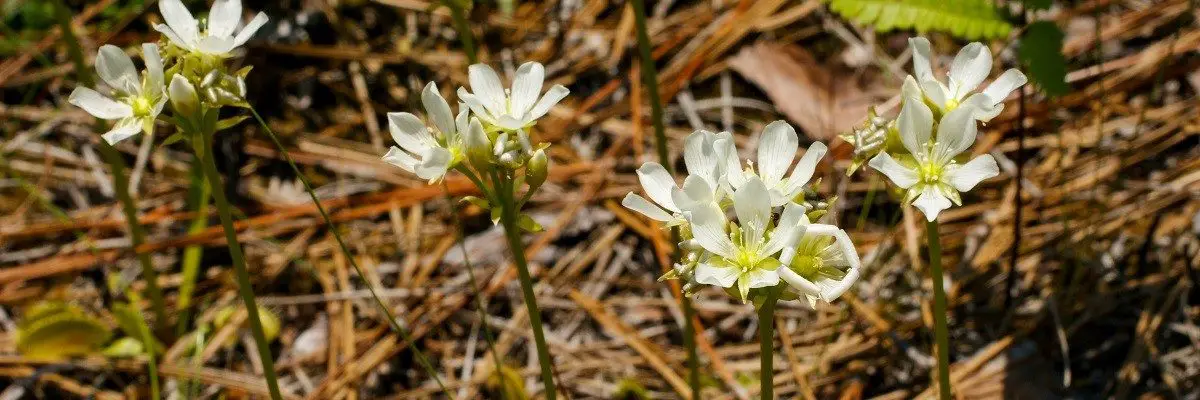Yes, it is a flower. Venus flytraps are flowering plants whose most notable characteristic is their carnivorous behavior. Each leaf has two hinged lobes at its end, forming a “trap.” Trichomes are hair-like projections that form on the inner surfaces of the lobes and cause them to snap shut when they come into contact with prey. Plants that respond to being touched by this type of movement are called thigmonasty. The trap only closes when the trichomes are touched repeatedly to prevent the plant from wasting energy if the prey is not actually present. Hinged traps have bristles on the edge that locks when the trap closes so the prey can’t get out. Other carnivorous plants exist in the wild, but the Venus flytrap is one of the few species actively trapping its prey.
Why does Venus fly traps flower?
Usually, around 2-4 years after reaching maturity, the Venus flytrap will produce flowers. Flowers are produced during
Venus flytraps have flowers for reproduction, just like any other plant. As soon as pollen is transferred to the stigma, flowers will begin to produce seeds for reproduction. One interesting thing about the process of pollination and the Venus flytrap is that most pollinators are well insects…, and the main prey of the Venus Flytrap is insects! Exactly how does this work?
The flowers of Venus flytraps will grow much taller than the traps themselves. When you study the flytrap, you’ll see that the flowers are at the top, and the traps are much lower down. The Venus flytrap adapted this ability in order to separate insects that pollinate them from the insects that are food.
The observation of long stems growing on a Venus Fly Trap is a cause of curiosity and puzzlement among many Venus Fly Trap growers. Venus Fly Traps that grow along stem might be growing a flower stalk, but it could also be false vivipary. You can tell a new flowering stalk by the long green stem with a bud or a few buds.
Venus Fly Traps flowers during the growing season (often between May and June). A healthy Venus Fly Trap will grow along a stem that usually emerges from its center if it’s in good condition. Eventually, one to several buds will appear on this green stalk, eventually turning into flowers. You can choose to cut a long stalk if it grows too tall. A long stalk can be thin or thick. Because the stalk of the flower is tall, the plant will not trigger its own trap.
One plant of the Venus Fly Trap can produce between one and twelve flowers on average per season. The flowers have five petals each. Long stems, however, may also be false vivipary, as previously mentioned. It is labeled false vivipary when a plant produces a plantlet instead of a flower stalk. False vivipary is not common in Venus flytraps, so you are most likely looking at a flower stalk on your trap. It is possible to cut off false vivipary at the base and plant them as new plants in the soil.
Food and pollinators coexist on two different levels within the plant. In the flowering phase of a Venus flytrap, the traps grow to a length of 4-5 inches. In this phase, the leaves are close to the ground, and the flowers are on top. Still, the flowers rise significantly higher than the traps. Venus flytrap’s flowers have evolved to separate from their leaves, so they don’t consume pollinators.
Should I let my Venus flytrap flower?
It is not recommended. An enormous amount of energy is expended by plants in making flowers. The blooming phase of a Venus flytrap is followed by nearly a year of sluggish growth. They usually get over this phase very quickly in the wild. Despite this, some plants may never be able to recover from this condition due to the conditions, since the light levels, humidity, and other conditions are not ideal. It is even possible that they may die. Because of this, unless you have spare plants or are a very experienced flytrap grower, you should clip the flower as soon as possible.s soon as you can.
In some cases, flowering might not be the best option if your plant has recently recovered from an insect infestation or plant rot. Plants that are weak should have their flower stalks cut off before blooming. Venus flytraps that are sick or weak might be unable to make it through the flowering process.
When Venus flytraps are in good health, they produce blooms during the early spring and continue to do so throughout the summer. If your plant is in good shape, you won’t miss out on flowering. The test is already passed when you’ve kept the plant for one year (or more). Carnivorous plants must be carefully researched before being bought, as many people kill shortly after purchasing them.

How to Cut the Venus Flytrap Flowers?
It is best to remove flower stalks as soon as possible. Please don’t wait till they have grown to remove them. Remove them as soon as possible. Due to their shape, the flowers and stalk are easy to identify. Use scissors to cut off the flower stalk from its bottom; once you have identified it, can be removed while preserving the surrounding leaves. Then, discard the cuttings, and consider propagating your plant by using the stalks.
Can Venus Flytrap Self Propagate?
It is possible for Venus flytraps to self-pollinate, which means they can fertilize their pistil with pollen from their own anthers. Nevertheless, most growers of Venus fly fraps agree that cross-pollinating the plant results in a higher number of seeds, a higher germination rate, and more robust seedlings. Taking pollen from one flower and fertilizing the pistil is known as cross-pollination. The term “completely different plant” refers to something different from a flower on the same plant or another genetically identical plant.
Can Venus Flytraps Die after Flowering?
Venus flytraps bloom during the spring. The process puts a lot of strain on the plant to make those flowers. It won’t die from the flowers, but it could die from poor conditions that do not promote growth. When your Venus flytrap flowers, it will be delicate for several months. You endanger your plant dying during those months if the surrounding environment is not right.

